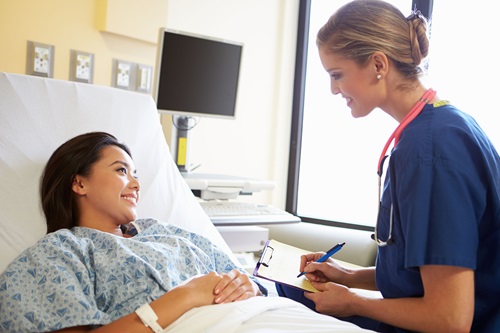What is an Upper Endoscopy (EGD)?

The procedure uses a thin scope with a light and camera at its tip, called an endoscope, to look inside the upper digestive system of the esophagus, stomach, and the first part of the small intestine. The endoscope is passed through the mouth and down the throat to the esophagus. It may also have a small biopsy instrument to remove tissue that is then checked under a microscope for abnormalities.
Benefits & Risks
An upper endoscopy can help determine causes for heartburn, the presence of hiatal hernias, the cause of abdominal pain, unexplained anemia, and the cause of swallowing difficulties, upper GI bleeding and the presence of tumors or ulcers.
Serious complications from this procedure are uncommon. There is a small chance of a hole forming in the stomach, duodenum, or esophagus from the scope moving through these areas. There is also a small risk of bleeding at the biopsy site.
What to Expect
Before your procedure, you will need to have an empty stomach. Your physician will request that you don’t eat or drink after midnight on the day of your procedure. Additionally, if you take any blood-thinning medication, your physician may request that you stop using for 3-5 days before the test.
The procedure usually takes 30 to 45 minutes. Before the procedure, anesthesiology will give you medication through a vein to help you relax and better tolerate any discomfort from the procedure. The procedure will begin with you lying on your left side. The scope will be passed through your mouth into the throat, stomach, and small intestine. If something abnormal is found, the physician may take a biopsy specimen or may use medication or heat treatment to stop any bleeding. The instrument used for the procedure will not interfere with your breathing.
Because air is introduced through the endoscope, you may feel some bloating during and after the procedure. You may resume your usual diet unless instructed otherwise by your physician. Your throat may also feel scratchy or sore after the procedure, but this feeling subsides quickly. Your physician will then explain your likelihood of complications based on the exam results. An EGD generally requires some anesthesia, which may make patients feel a bit woozy. Under these circumstances, patients are required to have a licensed driver take them back home.
Find a Provider
Learn more about Upper Endoscopy
Men and Esophageal Cancer
According to the Salgi Esophageal Cancer Research Foundation, esophageal cancer is among the fastest growing and deadliest cancers in the United States. Statistically, men are 3 to 4 times more likely than women to be diagnosed with esophageal cancer.
Read ArticleHow GERD Led to Esophageal Cancer
Billy suffered from severe heartburn and GERD for years. He never expected it would lead to cancer.
Read ArticleDebra had no idea she was bleeding internally…
If Debra Tucker had waited any longer before she called 911, she might not be alive today.
Read Article